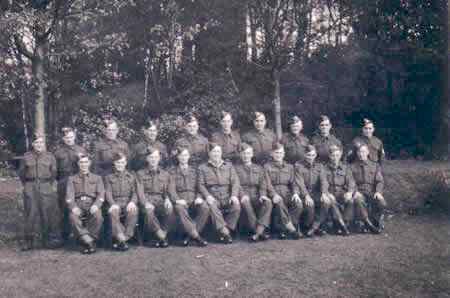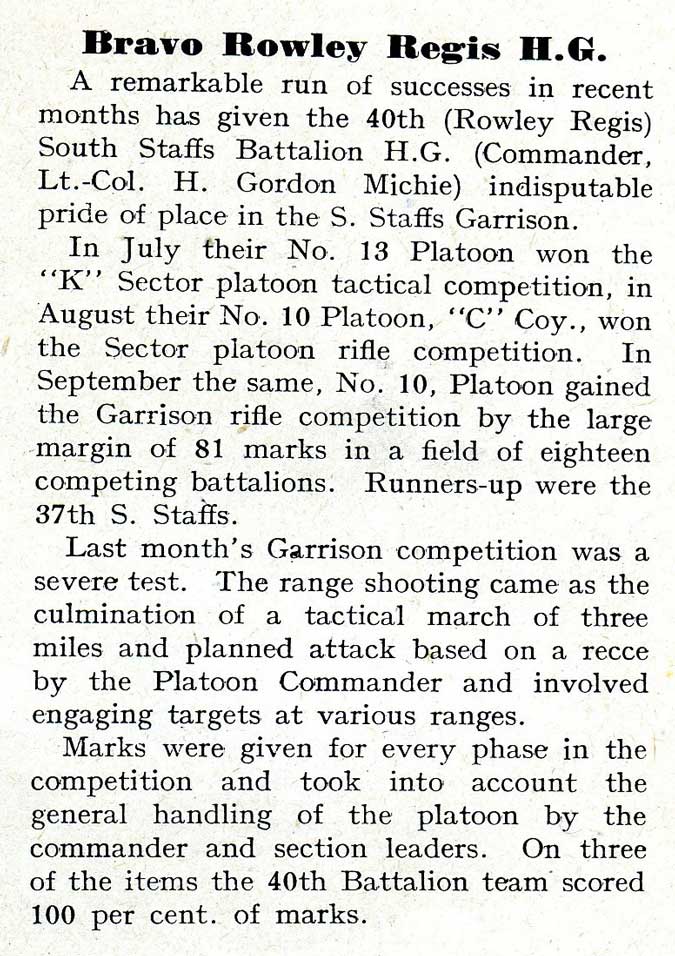MEMORIES
AND INFORMATION - STAFFORDSHIRE
ROWLEY
REGIS HOME GUARD
(40th STAFFORDSHIRE (ROWLEY REGIS) BATTN.)
This
is a page within the www.staffshomeguard.co.uk website.
To
see full contents, go to SITE
MAP.
|
Responsible for the defence of Rowley Regis
was the 40th Staffordshire (Rowley Regis) Battalion. Organisationally
this Battalion was grouped with its neighbours, the
38th
(Brierley Hill), 39th (Enville) and
41st (Tipton) Battalions. (Rowley Regis was then in Staffordshire before becoming part of Worcestershire in the postwar years).
In 2004 and 2006 there were a couple of
threads in
Rowley Regis
Online's Forum discussing the local Home Guard. Snippets
of information emerging were as follows:
A Home Guard base was in a building called "Unit Aid" in
Birmingham Road, just down from
McMillan Road on the same side. The building still exists, now behind a steel fence. Another suggestion is that a unit was based in
Hurst Green.
Drill practice used to take place in
Britannia Park.
One of the local unit's duties was to guard "Big Bertha" on
Rowley Hills.
There is a story whereby in the blackout the unit succeeded in marching a visiting colonel and his staff into the cut.
(Translation into non-Black Country English: cut = canal).
|
A 1943 photograph of the unit has also survived,
taken in Lench's Grounds. The only identified members are:
George Baker, back row, 5th from the right and
Frank Phipps, front row, 3rd from right.
The unit would have been part of the
40th Staffordshire (Rowley Regis) Battalion who were responsible for the defence of the area.

In the platoon in which Frank Phipps served there were two men of the same surname although not related. Frank lived in
Mincing Lane, the other man in
Uplands Avenue. Frank himself was involved in anti-aircraft defence. The local gun or battery of guns on
Turner's Hill where he served for part of his Home Guard service was nicknamed locally
"Big Bertha" and when fired shook the surrounding area, not least the houses in Mincing Lane.
A visitor to this website has provided further information about two men who worked at
T.W. Lench and very likely also belonged to the local unit.
One was her father, John Scannell, originally from South Wales. His workmate and fellow countryman was
Mostyn Lucas. They both lodged in
Brook Street in
Old Hill. At some stage in their Home Guard career both served in the anti-aircraft battery at Turners Hill. During his time at T.W. Lench, John met and subsequently married Doris Lowe. He went on to serve in India.

By the summer of 1944, the 40th Battalion under the command of
Lt.-Col. H. Gordon Michie had clearly achieved a high level of expertise in various areas of activity.
This report in the October 1944 issue of the magazine "Defence" gives an indication of their achievement.
Martin Crump writes to
staffshomeguard
(October 2015):
My Dad was in the Home Guard at that time,
he spoke many times about Big Bertha, the gun he
worked on. His name was Claude Crump and he worked at
Lench's for a short time. I was born in one of
Lench's houses in Ross. He used to talk about someone
called Indian Joe who he was in the Home Guard with.
Webmaster note:
There is information online (2019)
to the effect that Big Bertha was in fact not a single
gun but a battery of several. This is possible.
There is also a suggestion that the Home Guard was
never involved directly in the operation of this
anti-aircraft equipment but had a responsibility for
site defence only. This is almost certainly incorrect.
It is in contradiction with Martin Crump's, and other,
reminiscences above; and also the general practice in
the West Midlands and elsewhere from late 1942 onwards
when Home Guards took over most of the manning of
their local batteries, both Heavy Anti-Aircraft and
Rocket batteries. Regular Royal Artillery troops were
thereby released for other duties as the liberation of
Europe approached.
On 21st
December 1940 a dreadful tragedy occurred at the
Boat Inn, Tividale.
An anti-aircraft shell fell during a wedding
reception, leading to the deaths of 12 people. It
appears that no air-raid was in progress at the time
and the incident's cause was attributed to an
accidental discharge of "Big Bertha". There is a
memoir written by a member of the 40th Battalion who
describes the probable circumstances and the
catastrophic mistake made. But there is no suggestion
of any direct involvement of Home Guards so early in
the war and the error would have been made by the
original Royal Artillery crew.
ACKNOWLEDGEMENTS
Grateful acknowledgement is made to Rowley Regis Online
and its contributors; to the daughters of Frank
Phipps and John Scannell for family information; to
MJ for allowing us to reproduce the picture; to the
long defunct "Defence" magazine;
to Mick Ackrill and
to Martin Crump.
Any further details about the Rowley Regis Home Guard, to add to the above rather sketchy information, would be warmly welcomed. Please use
FEEDBACK. |